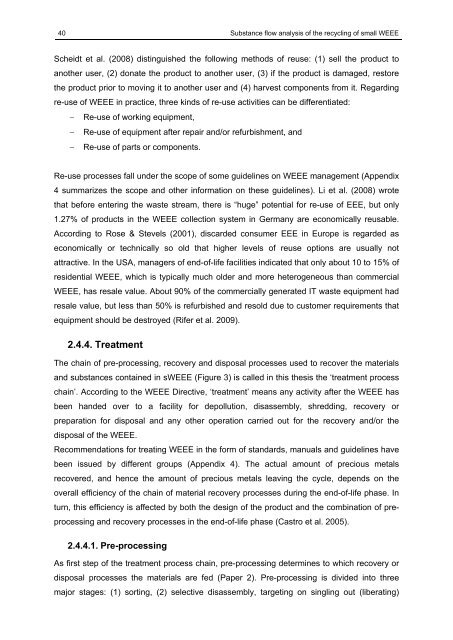SUbstance flow analysis of the recycling of small waste electrical ...
SUbstance flow analysis of the recycling of small waste electrical ...
SUbstance flow analysis of the recycling of small waste electrical ...
Create successful ePaper yourself
Turn your PDF publications into a flip-book with our unique Google optimized e-Paper software.
40 Substance <strong>flow</strong> <strong>analysis</strong> <strong>of</strong> <strong>the</strong> <strong>recycling</strong> <strong>of</strong> <strong>small</strong> WEEE<br />
Scheidt et al. (2008) distinguished <strong>the</strong> following methods <strong>of</strong> reuse: (1) sell <strong>the</strong> product to<br />
ano<strong>the</strong>r user, (2) donate <strong>the</strong> product to ano<strong>the</strong>r user, (3) if <strong>the</strong> product is damaged, restore<br />
<strong>the</strong> product prior to moving it to ano<strong>the</strong>r user and (4) harvest components from it. Regarding<br />
re-use <strong>of</strong> WEEE in practice, three kinds <strong>of</strong> re-use activities can be differentiated:<br />
Re-use <strong>of</strong> working equipment,<br />
Re-use <strong>of</strong> equipment after repair and/or refurbishment, and<br />
Re-use <strong>of</strong> parts or components.<br />
Re-use processes fall under <strong>the</strong> scope <strong>of</strong> some guidelines on WEEE management (Appendix<br />
4 summarizes <strong>the</strong> scope and o<strong>the</strong>r information on <strong>the</strong>se guidelines). Li et al. (2008) wrote<br />
that before entering <strong>the</strong> <strong>waste</strong> stream, <strong>the</strong>re is “huge” potential for re-use <strong>of</strong> EEE, but only<br />
1.27% <strong>of</strong> products in <strong>the</strong> WEEE collection system in Germany are economically reusable.<br />
According to Rose & Stevels (2001), discarded consumer EEE in Europe is regarded as<br />
economically or technically so old that higher levels <strong>of</strong> reuse options are usually not<br />
attractive. In <strong>the</strong> USA, managers <strong>of</strong> end-<strong>of</strong>-life facilities indicated that only about 10 to 15% <strong>of</strong><br />
residential WEEE, which is typically much older and more heterogeneous than commercial<br />
WEEE, has resale value. About 90% <strong>of</strong> <strong>the</strong> commercially generated IT <strong>waste</strong> equipment had<br />
resale value, but less than 50% is refurbished and resold due to customer requirements that<br />
equipment should be destroyed (Rifer et al. 2009).<br />
2.4.4. Treatment<br />
The chain <strong>of</strong> pre-processing, recovery and disposal processes used to recover <strong>the</strong> materials<br />
and substances contained in sWEEE (Figure 3) is called in this <strong>the</strong>sis <strong>the</strong> ‘treatment process<br />
chain’. According to <strong>the</strong> WEEE Directive, ‘treatment’ means any activity after <strong>the</strong> WEEE has<br />
been handed over to a facility for depollution, disassembly, shredding, recovery or<br />
preparation for disposal and any o<strong>the</strong>r operation carried out for <strong>the</strong> recovery and/or <strong>the</strong><br />
disposal <strong>of</strong> <strong>the</strong> WEEE.<br />
Recommendations for treating WEEE in <strong>the</strong> form <strong>of</strong> standards, manuals and guidelines have<br />
been issued by different groups (Appendix 4). The actual amount <strong>of</strong> precious metals<br />
recovered, and hence <strong>the</strong> amount <strong>of</strong> precious metals leaving <strong>the</strong> cycle, depends on <strong>the</strong><br />
overall efficiency <strong>of</strong> <strong>the</strong> chain <strong>of</strong> material recovery processes during <strong>the</strong> end-<strong>of</strong>-life phase. In<br />
turn, this efficiency is affected by both <strong>the</strong> design <strong>of</strong> <strong>the</strong> product and <strong>the</strong> combination <strong>of</strong> preprocessing<br />
and recovery processes in <strong>the</strong> end-<strong>of</strong>-life phase (Castro et al. 2005).<br />
2.4.4.1. Pre-processing<br />
As first step <strong>of</strong> <strong>the</strong> treatment process chain, pre-processing determines to which recovery or<br />
disposal processes <strong>the</strong> materials are fed (Paper 2). Pre-processing is divided into three<br />
major stages: (1) sorting, (2) selective disassembly, targeting on singling out (liberating)

















